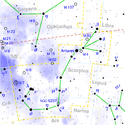SN 393
| Supernova Typ: II/Ib | |
|---|---|
| SN 393 | |
 | |
| Sternbild Scorpion | |
| Position Äquinoktium: J2000.0 | |
| Rektaszension | 17h 14m 0s |
| Deklination | −39.8° 0′ 0″ |
| Weitere Daten | |
| Helligkeit (visuell) | −1 mag |
| Entfernung | 1 kpc |
| Geschichte | |
| Katalogbezeichnungen | |
| AladinLite | |
SN 393 ist die moderne Bezeichnung für ein astronomisches Ereignis, welches 393 n. Chr. von Chinesen beobachtet wurde. Es erreichte eine scheinbare Helligkeit von schätzungsweise −1 mag und war etwa acht Monate lang sichtbar. Die Dauer des Ereignisses lässt darauf schließen, dass es sich um eine Supernova handeln könnte. Dies ist in diesem Fall wahrscheinlicher als eine Nova, weil bisher kein hervorragender Nova-Kandidat identifiziert wurde. Allein nach der Dauer könnte auch eine Nova gewesen sein,[1] da Novae mit t3-Zeiten von bis zu zehn Monaten bekannt sind.[2][3] Die t3 Zeit ist die Dauer, in der eine Nova um 3 mag abklingt. Falls das Objekt schätzungsweise −1 mag hell war, wäre es im Fall einer schnellen Nova mit typischer t3-Zeit von ein bis zwei Monaten immer noch so hell wie der Polarstern und noch lange sichtbar.
Siehe auch
Quellen
- SN 393 – SuperNova. In: SIMBAD. Centre de Données astronomiques de Strasbourg, abgerufen am 16. Juli 2011.
Weiterführende Literatur
- Zhen-Ru Wang: The Impact of Historical Chinese Astronomical Records. In: Astrophysics and Space Science. Band 305, Nr. 3, 1. Dezember 2006, S. 207–210, doi:10.1007/s10509-006-9187-8, bibcode:2006Ap&SS.305..207W.
- D. H. Clark, F. R. Stephenson: The remnants of the supernovae of AD 185 and AD 393. In: The Observatory. 95. Jahrgang, Oktober 1975, S. 190–195, bibcode:1975Obs....95..190C.
- D. H. Clark, F. R. Stephenson: Which historical new stars were supernovae. In: Quarterly Journal of the Royal Astronomical Society. 17. Jahrgang, September 1976, S. 290–302, bibcode:1976QJRAS..17..290C.
- Z.-R. Wang, Q. Y. Qu, Y. Chen: The AD 393 Guest Star; the SNR RX 51713.7-3946. In: Katsuji Koyama, Shunji Kitamoto, Masayuki Itoh (Hrsg.): The Hot Universe. Proceedings of IAU Symposium #188. Kluwer Academic, Dordrecht 1998, S. 262, bibcode:1998IAUS..188..262W.
- F. Acero, J. Ballet, A. Decourchelle et al.: A joint spectro-imaging analysis of the XMM-Newton and HESS observations of the supernova remnant RX J1713.7-3946. In: Astronomy and Astrophysics. 505. Jahrgang, Nr. 1, Oktober 2009, S. 157–167, doi:10.1051/0004-6361/200811556, bibcode:2009A&A...505..157A.
- E. G. Berezhko, H. J. Völk: Nonthermal and thermal emission from the supernova remnant RX J1713.7-3946. In: Astronomy and Astrophysics. 511. Jahrgang, Februar 2010, doi:10.1051/0004-6361/200913312, arxiv:0910.2094, bibcode:2010A&A...511A..34B.
Einzelnachweise
- ↑ Susanne M. Hoffmann, Nikolaus Vogt: A search for the modern counterparts of the Far Eastern guest stars 369 CE, 386 CE and 393 CE. In: Monthly Notices of the Royal Astronomical Society. Band 497, 1. Juli 2020, S. 1419–1433, doi:10.1093/mnras/staa1970, bibcode:2020MNRAS.497.1419H.
- ↑ Richard J. Strope, Bradley E. Schaefer, Arne A. Henden: Catalog of 93 Nova Light Curves: Classification and Properties. In: The Astronomical Journal. Band 140, 1. Juli 2010, S. 34–62, doi:10.1088/0004-6256/140/1/34, bibcode:2010AJ....140...34S.
- ↑ Susanne M. Hoffmann, Nikolaus Vogt: Cataclysmic variables as possible counterparts of ancient Far Eastern guest stars. In: Monthly Notices of the Royal Astronomical Society. Band 494, 1. Mai 2020, S. 5775–5786, doi:10.1093/mnras/staa1162, bibcode:2020MNRAS.494.5775H.
Auf dieser Seite verwendete Medien
Autor/Urheber: Torsten Bronger., Lizenz: CC BY-SA 3.0
This is a celestial map of the constellation Scorpius, the Scorpion.
The yellow dashed lines are constellation boundaries, the red dashed line is the ecliptic, and the shades of blue show Milky Way areas of different brightness. The map contains all Messier objects, except for colliding ones. The underlying database contains all stars brighter than 6.5. All coordinates refer to equinox 2000.0.
The map is calculated with the equidistant azimuthal projection (the zenith being in the center of the image). The north pole is to the top. The (horizontal) lines of equal declination are drawn for 0°, ±10°, ±20° etc. The lines of equal right ascension are drawn for all 24 hours. Towards the rim there is a very slight magnification (and distortion).